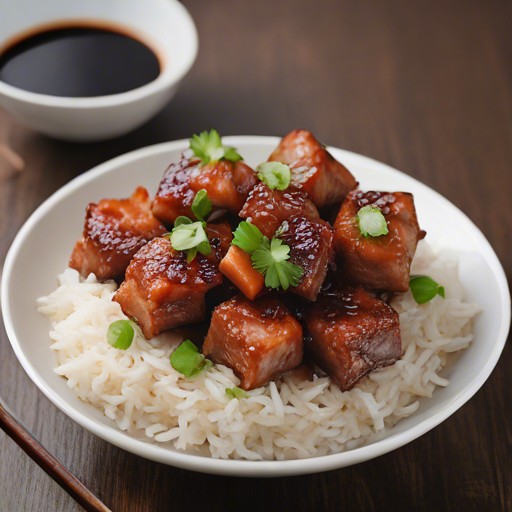A Culinary Heritage: Crafting Thit Kho (Caramelized Pork Belly) with Time-Honored Flavors
Embark on a gastronomic journey steeped in tradition as we delve into the art of crafting Thit Kho—Caramelized Pork Belly, a Vietnamese dish that encapsulates the rich tapestry of flavors and cultural heritage. Join us as we explore the intricacies of creating this savory masterpiece that transforms humble ingredients into a symphony of taste, embodying the essence of Vietnamese home-cooked meals.
Ingredients:
For Thit Kho:
- 1.5 lbs pork belly, skin-on, sliced into bite-sized pieces
- 1 cup coconut water
- 1/4 cup fish sauce
- 1/4 cup soy sauce
- 2 tablespoons sugar
- 4 cloves garlic, minced
- 1 shallot, finely chopped
- 1 teaspoon black pepper
- Hard-boiled eggs (optional)
- Green onions and cilantro for garnish
Instructions:
1. Preparing the Pork Belly:
- Cut the pork belly into bite-sized pieces, ensuring the skin is left on for a delightful texture.
2. Caramelizing Sugar:
- In a large pot or braising pan, heat sugar over medium heat until it melts and turns into a golden caramel.
3. Searing the Pork:
- Add minced garlic and chopped shallots to the caramel, stirring until fragrant. Add the pork belly pieces and sear until they develop a golden brown color.
4. Infusing Flavors:
- Pour in fish sauce, soy sauce, and black pepper. Stir to coat the pork evenly with the savory mixture.
5. Adding Coconut Water:
- Pour coconut water into the pot, ensuring the pork is mostly submerged. Bring the mixture to a gentle simmer.
6. Braising to Perfection:
- Cover the pot and let the pork braise on low heat for approximately 1.5 to 2 hours, or until the pork is tender and the flavors are fully absorbed.
7. Optional Addition:
- If desired, add hard-boiled eggs to the pot during the last 30 minutes of cooking, allowing them to absorb the rich flavors.
8. Garnishing and Serving:
- Garnish the Thit Kho with chopped green onions and cilantro. Serve over steamed rice for a complete and satisfying meal.
Cook Notes and Variations:
- Coconut Extravaganza: For an extra coconut kick, replace coconut water with coconut soda.
- Five-Spice Fusion: Add a pinch of five-spice powder for a unique aromatic twist.
- Pineapple Pleasure: Introduce pineapple chunks during the braising process for a sweet and tangy variation.
Keto and Low Carb Versions:
Keto Thit Kho:
- Replace sugar with a keto-friendly sweetener like erythritol or stevia.
- Ensure the fish sauce and soy sauce used are low-carb or gluten-free alternatives.
Low Carb Thit Kho:
- Use a moderate amount of coconut water to control carb content.
- Opt for a low-carb substitute for sugar.
Frequently Asked Questions (FAQs):
Q: Can I use pork with the skin removed? A: While traditional Thit Kho includes the skin for a unique texture, you can use skinless pork belly if preferred.
Q: What’s the difference between fish sauce and soy sauce? A: Fish sauce has a distinct umami flavor, while soy sauce contributes a savory and slightly sweet taste. The combination adds depth to Thit Kho.
Q: Can I make Thit Kho ahead of time? A: Thit Kho actually tastes better when allowed to sit and absorb flavors. Prepare it in advance, refrigerate, and reheat before serving.
Q: Are there vegetarian alternatives for Thit Kho? A: While it’s challenging to replicate the exact flavors, you can experiment with tofu or seitan using a similar caramelization technique.
Q: What’s the significance of Thit Kho in Vietnamese culture? A: Thit Kho is a staple in Vietnamese households, often enjoyed during Lunar New Year celebrations. Its rich flavors symbolize abundance and prosperity.
A Culinary Odyssey in Every Bite
In conclusion, Thit Kho transcends culinary boundaries, offering a taste of Vietnamese tradition in every succulent bite. Whether you follow the classic recipe or explore variations to suit dietary preferences, this dish is a testament to the art of slow cooking and the ability to transform simple ingredients into a culinary masterpiece. So, immerse yourself in the savory allure of Thit Kho, savor the caramelized perfection, and relish the cultural heritage embedded in this timeless Vietnamese dish. Happy cooking!

